Ventilation as an Indispensable Tool for Healthy Constructions: Comparison of Alicante’s Urban Railway Tunnels
Abstract
1. Introduction
2. Indoor Air Quality and Health
- The absence of data concerning women and children who obviously did not work in the mines.
- Uncertainties in the health effect of the dose rate.
- Lack of data on smoking habits in most studies.
- Inadequate control of other confusing variables (such as exposure to gamma radiation or suspended aerosols).
2.1. Importance of Ventilation in the Construction Phase of Tunnels
2.2. Radon Gas As an Indicator of Ventilation
3. Measuring Zones
3.1. The Benacantil Mount Railway Tunnel
3.2. The Serra Grossa Railway Tunnel
4. Comparison of Air Quality. Radon Gas as a Control Element
4.1. Study of Air Quality in the Benacantil Mount Tunnel
- Zone 1
- Zone 2
- Zone 3
- Zone 4
- Zone 5
- Zone 6
4.1.1. Data Collection Process in the Benacantil Mount Tunnel
4.1.2. Results Obtained in the Study of Benacantil Mount
4.2. Study of Air Quality in the Serra Grossa Tunnel
- Zone 1
- Zone 2
- Zone 3
- Zone 4
- Zone 5
- Zone 6
- Zone 7
- Zone 8
4.2.1. Data Collection Process in the Serra Grossa Tunnel
4.2.2. Results Obtained in the Serra Grossa Study
5. Discussion of Results
5.1. Summary of the Results of the Benacantil Mount Tunnel Measurement
5.2. Summary of the Results of the Serra Grossa Tunnel Measurement
5.3. Comparison of Results
6. Conclusions
7. Future Lines of Research
- In the field of construction, new techniques must be implemented that incorporate greater protections and barriers that prevent the entry of radon gas produced by ground contact.
- Construction materials should focus on achieving non-generation of radon gas by moving away from the elements of their chain of semidesintegration in their composition.
- Regulations concerning the maximum permitted quantities of radon gas in buildings, as well as measures to be taken from certain concentration levels, must be developed and made mandatory to control the presence of this gas in buildings. It has been found that the levels of this gas can be excessively high even in areas not considered to be at risk.
- Measures should be implemented for constructions located on the land with high values of radon gas concentration to help reduce the dose of human exposure. These measures should focus both on ventilation and indoor air renewal and direct methods of capturing and expelling gas from inside buildings.
- In the field of radioprotection, the dose that a person can support in particular cases should be investigated using appropriate dosimetry models.
- In the particular case of the study shown, we intended to measure the tunnel of the Serra Grossa Mountain after the works and already in operation, to check the proper ventilation and, therefore, air quality.
Author Contributions
Funding
Acknowledgments
Conflicts of Interest
References
- Tung, T.C.; Chan, D.W.; Burnett, J. An empirical radon emanation model for residential premises. Build. Environ. 2005, 40, 1566–1571. [Google Scholar] [CrossRef]
- Collignan, B.; Powaga, E. Procedure for the characterization of radon potential in existing dwellings and to assess the annual average indoor radon concentration. J. Environ. Radioact. 2014, 137, 64–70. [Google Scholar] [CrossRef] [PubMed]
- Istrate, M.A.; Catalina, T.; Cucos, A.; Dicu, T. Experimental Measurements of VOC and Radon in Two Romanian Classrooms. Energy Proced. 2016, 85, 288–294. [Google Scholar] [CrossRef][Green Version]
- Porstendörfer, J. Properties and behaviour of radon and thoron and their decay products in the air. J. Aerosol Sci. 1994, 25, 219–263. [Google Scholar] [CrossRef]
- Järnström, H. Reference Values for Building Material Emissions and Indoor Air Quality in Residential Buildings; Pub. Prima Oy: Helsinki, Finland, 2008. [Google Scholar]
- Webb, P.C. Radioactivity in geology: Principles and applications by E. M. Durrance (Ellis Horwood series in Geology), Ellis Horwood Ltd, Chichester, England, 1986. no. of pages: 441. price: £59.50 (hardback). Geol. J. 2007, 23, 104–105. [Google Scholar] [CrossRef]
- International Atomic Energy Agency. Guidelines for Radioelement Mapping Using Gamma Ray Spectrometry Data; Nuclear Fuel Cycle and Materials Section International Atomic Energy Agency: Vienna, Austria, 2003; p. 179. [Google Scholar]
- Nagaraja, K.; Prasad, B.S.N.; Madhava, M.S.; Chandrashekara, M.S.; Paramesh, L.; Sannappa, J.; Pawar, S.D.; Murugavel, P.; Kamra, A.K. Radon and its short-lived progeny: Variations near the ground. Radiat. Meas. 2003, 36, 413–417. [Google Scholar] [CrossRef]
- Wanty, R.B. Field Studies of Radon in Rocks, Soils, and Water; L.C.S. Gundersen: Washington, DC, USA, 1991. [Google Scholar]
- Edwards, R.D.; Jurvelin, J.; Koistinen, K.; Saarela, K.; Jantunen, M. VOC source identification from personal and residential indoor, outdoor and workplace microenvironment samples in EXPOLIS-Helsinki, Finland. Atmos. Environ. 2001, 35, 4829–4841. [Google Scholar] [CrossRef]
- Tchorz-Trzeciakiewicz, D.E.; Klos, M. Factors affecting atmospheric radon concentration, human health. Sci. Total. Environ. 2017, 584–585, 911–920. [Google Scholar] [CrossRef]
- Jönsson, G. Radon gas—where from and what to do? Radiat. Meas. 1995, 25, 537–546. [Google Scholar] [CrossRef]
- Kim, S.H.; Hwang, W.J.; Cho, J.S.; Kang, D.R. Attributable risk of lung cancer deaths due to indoor radon exposure. Ann. Occup. Environ. Med. 2016, 28, 8. [Google Scholar] [CrossRef]
- 90/143/EURATOM. Recommendation of the EURATOM Commission of 21 February 1990 on the Protection of the General Public against the Dangers of Exposure to Radon inside Buildings; Europe Union, 1990; Available online: https://op.europa.eu/en/publication-detail/-/publication/260b2024-21d9-4de5-ae3f-d7867a15d221/language-en (accessed on 23 October 2019).
- Lavi, N.; Steiner, V.; Alfassi, Z.B. Measurement of radon emanation in construction materials. Radiat. Meas. 2009, 44, 396–400. [Google Scholar] [CrossRef]
- Maestre, C.R.; Yepes, S.C. Detection and importance of the presence of Radon Gas in buildings. Int. J. Eng. Tech. Res. (IJETR) 2016, 4, 67–70. [Google Scholar]
- Andersson, K.G. Radioactivity in the Environment. In Airborne Radioactive Contamination in Inhabited Areas; Elservier: London, UK, 2009; Volume 15. [Google Scholar]
- United Nations; Scientific Committee on the Effects of Atomic Radiation. Sources and Effects of Ionizing Radiation: United Nations Scientific Committee on the Effects of Atomic Radiation: UNSCEAR 2000 Report to the General Assembly, with Scientific Annexes; Elsevier Science: Amsterdam, The Netherlands, 2000. [Google Scholar]
- Cristobo, J.J.J.L. Medición de la Concentración de Gas 222Rn en el Interior de Edificios; USC. Departamento de Física de las Partículas: Compostela, Spain, 2006; p. 64. [Google Scholar]
- Cuvier, A.; Panza, F.; Pourcelot, L.; Foissard, B.; Cagnat, X.; Prunier, J.; van Beek, P.; Souhaut, M.; Roux, G.L. Uranium decay daughters from isolated mines: Accumulation and sources. J. Environ. Radioact. 2015, 149, 110–120. [Google Scholar] [CrossRef] [PubMed]
- Szabó, K.Z.; Jordan, G.; Horváth, Á.; Szabó, C. Mapping the geogenic radon potential: Methodology and spatial analysis for central Hungary. J. Environ. Radioact. 2014, 129, 107–120. [Google Scholar] [CrossRef]
- Collignan, B.; Powaga, E. Impact of ventilation systems and energy savings in a building on the mechanisms governing the indoor radon activity concentration. J. Environ. Radioact. 2017. [Google Scholar] [CrossRef]
- Boerma, M.; Sridharan, V.; Mao, X.W.; Nelson, G.A.; Cheema, A.K.; Koturbash, I.; Singh, S.P.; Tackett, A.J.; Hauer-Jensen, M. Effects of ionizing radiation on the heart. Mutat. Res. Mutat. Res. 2016, 770, 319–327. [Google Scholar] [CrossRef]
- Bhattacharya, S.; Asaithamby, A. Ionizing radiation and heart risks. Semin. Cell Dev. Biol. 2016, 58, 14–25. [Google Scholar] [CrossRef]
- Ravanat, J.L.; Douki, T. UV and ionizing radiations induced DNA damage, differences and similarities. Radiat. Phys. Chem. 2016, 128, 92–102. [Google Scholar] [CrossRef]
- Amber, I.; O’Donovan, T.S. Natural convection induced by the absorption of solar radiation: A review. Renew. Sustain. Energy Rev. 2018, 82, 3526–3545. [Google Scholar] [CrossRef]
- Rizo-Maestre, C.; Chinchón Yepes, S. Radon Gas-Hazardous element for human life really found in the environment. In Proceedings of the 2nd International Conference on Green Materials and Environmental Engineering, Phuket, Thailand, 20–21 December 2015; Editor Atlantis Press: Hyderabad, India, 2015; pp. 60–62. [Google Scholar]
- Consejo de Seguridad Nuclear. Dosis de Radiación; Consejo de Seguridad Nacional: Madrid, España, 2010; p. 18. [Google Scholar]
- Barbosa-Lorenzo, R.; Ruano-Ravina, A.; Caramés, S.C.; Barros-Dios, J.M. Radón residencial y cáncer de pulmón. Un estudio ecológico en Galicia. Med. ClÍNica 2015, 144, 304–308. [Google Scholar] [CrossRef]
- Nastro, V.; Carni, D.L.; Vitale, A.; Lamonaca, F.; Vasile, M. Passive and active methods for Radon pollution measurements in historical heritage buildings. Measurement 2018, 114, 526–533. [Google Scholar] [CrossRef]
- Li, P.; Zhang, R.; Gu, M.; Zheng, G. Uptake of the natural radioactive gas radon by an epiphytic plant. Sci. Total. Environ. 2018, 612, 436–441. [Google Scholar] [CrossRef] [PubMed]
- Zeeb, H. International Radon Project. Survey On Radon Guidelines, Programmes and Activities; WHO HSE/PHE/RAD, 2007; p. 49. Available online: https://www.who.int/ionizing_radiation/env/radon/IRP_Survey_on_Radon.pdf (accessed on 23 October 2019).
- NTP 440: Radón en Ambientes Interiores; Ministerio de Trabajo y Asuntos Sociales: Madrid, Spain, 1999.
- Amgarou, K. Long-Term Measurements of Indoor Radon and Its Progeny in the Presence of Thoron Using Nuclear Track Detectors a Novel Approach; Universitat Autònoma de Barcelona: Barcelona, Spain, 2003. [Google Scholar]
- Yoon, J.Y.; Lee, J.D.; Joo, S.W.; Kang, D.R. Indoor radon exposure and lung cancer: A review of ecological studies. Ann. Occup. Environ. Med. 2016, 28, 15. [Google Scholar] [CrossRef] [PubMed]
- Cambeses, A.; Garcia-Casco, A.; Scarrow, J.H.; Montero, P.; Pérez-Valera, L.A.; Bea, F. Mineralogical evidence for lamproite magma mixing and storage at mantle depths: Socovos fault lamproites, SE Spain. Lithos 2016, 266–267, 182–201. [Google Scholar] [CrossRef]
- Duval, J.S. Use of aerial gamma-ray data to estimate relative amounts of radon in soil gas. In Field Studies of Radon in Rocks, Soils, and Water; CRC Press: Boca Raton, FL, USA, 1991; pp. 155–161. ISBN 9780873719551. [Google Scholar]
- Tanner, A.B. Methods of characterization of ground for assessment of indoor radon potential at a site. In Field Studies of Radon in Rocks, Soils, and Water; 1991; Available online: https://inis.iaea.org/search/searchsinglerecord.aspx?recordsFor=SingleRecord&RN=23074574 (accessed on 23 October 2019).
- Ielsch, G.; Cushing, M.E.; Combes, P.; Cuney, M. Mapping of the geogenic radon potential in France to improve radon risk management: Methodology and first application to region Bourgogne. J. Environ. Radioact. 2010, 101, 813–820. [Google Scholar] [CrossRef]
- Kemski, J.; Siehl, A.; Stegemann, R.; Valdivia-Manchego, M. Mapping the geogenic radon potential in Germany. Sci. Total. Environ. 2001, 272, 217–230. [Google Scholar] [CrossRef]
- Neznal, M.; Matolín, M.; Barnet, I.; Mikšová, J. The new method for assessing the radon risk of building sites. In Prace Ceskeho Geologickeho Ustavu; 2004; pp. 7–47. Available online: https://www.radon-vos.cz/pdf/metodika.pdf (accessed on 23 October 2019).
- Buttafuoco, G.; Tallarico, A.; Falcone, G. Mapping Soil Gas Radon Concentration: A Comparative Study of Geostatistical Methods. Environ. Monit. Assess. 2007, 131, 135–151. [Google Scholar] [CrossRef]
- Olaya, M.; Borja, F. El Código Técnico de la Edificación en España (CTE) Medidas correctoras destinadas a frenar la entrada de radón en los edificios. Investig. Campo Como Exp. Piloto Espa NA. 2007. Available online: https://www.radon-vos.cz/pdf/metodika.pdf (accessed on 23 October 2019).
- Cepedal, A.; Fuertes-Fuente, M.; Martín-Izard, A.; García-Nieto, J.; Boiron, M.C. An intrusion-related gold deposit (IRGD) in the NW of Spain, the Linares deposit: Igneous rocks, veins and related alterations, ore features and fluids involved. J. Geochem. Explor. 2013, 124, 101–126. [Google Scholar] [CrossRef]
- Rizo-Maestre, C.; Víctor, E. The Importance of Checking Indoor Air Quality in Underground Historic Buildings Intended for Tourist Use. Sustainability 2019, 11, 689. [Google Scholar] [CrossRef]
- Rizo-Maestre, C.; Víctor, E. The Radon Gas in Underground Buildings in Clay Soils. The Plaza Balmis Shelter as a Paradigm. Int. J. Environ. Res. Public Health 2018, 15, 1004. [Google Scholar] [CrossRef]
- Ruiz, R.A. Castellología medieval alicantina. Rev. Inst. Estud. Alicant. (IEA). Available online: https://www.iberlibro.com/buscar-libro/titulo/castellolog%EDa-medieval-alicantina-%E1rea-meridional/autor/azuar-ruiz/ (accessed on 23 October 2019).
- Rosser, P.; Quiles, I.; Limiñana, P.R. Sistema Defensivo Bajomedieval de la Villa Cristiana de Alicante, 1st ed.; Ayuntamiento de Alicante, 1996; Available online: https://www.radon-vos.cz/pdf/metodika.pdf (accessed on 23 October 2019).
- Colomer, M.B. Ereta del Benacantil. In Actuaciones Arqueol{ó}gicas en la Provincia de Alicante; 2000; ISBN 978-84-695-6558-2. Available online: https://dialnet.unirioja.es/servlet/articulo?codigo=809221 (accessed on 23 October 2019).
- Civera, I.A. Arquitecturas del TRAM Metrolopolitano de Alicante: La Estación de Luceros, Nueva Plaza en la Ciudad; Cátedra Demetrio Ribes UVEG-FGV, 2010; p. 48. Available online: http://150ferrocarrilalicante.catedradr.com/archivos/descargas/PDF_16_opt.pdf (accessed on 23 October 2019).
- Di, H.; Zhou, S.; Xiao, J.; Gong, Q.; Luo, Z. Investigation of the long-term settlement of a cut-and-cover metro tunnel in a soft deposit. Eng. Geol. 2016, 204, 33–40. [Google Scholar] [CrossRef]
- Payá, A.C. Estudio de un fenómeno de desprendimiento de rocas (rock-fall) en la Sierra de San Julián (Alicante). Investig. GeográFicas 1985, 3, 31–51. [Google Scholar] [CrossRef]
- Groves-Kirkby, C.J.; Crockett, R.G.M.; Denman, A.R.; Phillips, P.S. A critical analysis of climatic influences on indoor radon concentrations: Implications for seasonal correction. J. Environ. Radioact. 2015, 148, 16–26. [Google Scholar] [CrossRef] [PubMed]
- Miguel, M.G.T.S.; Matarranz, J.L.M.; de Mingo, R.G.; Cadierno, J.P.G.; Mahou, E.S. El Mapa Predictivo de Exposición al Radón en España; Editor Consejo de Seguridad Nuclear: Madrid, Spain, 2013; p. 102. [Google Scholar]
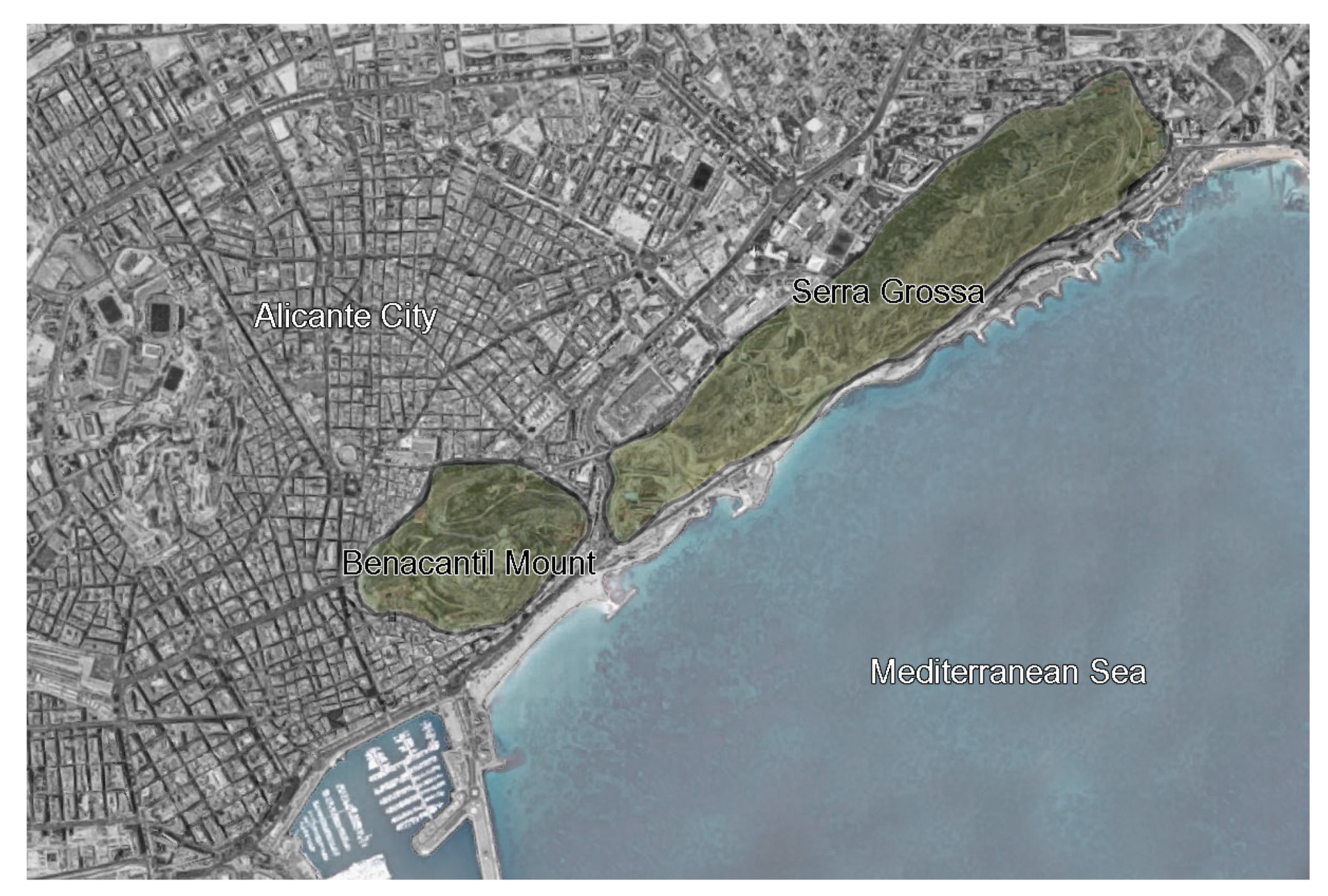

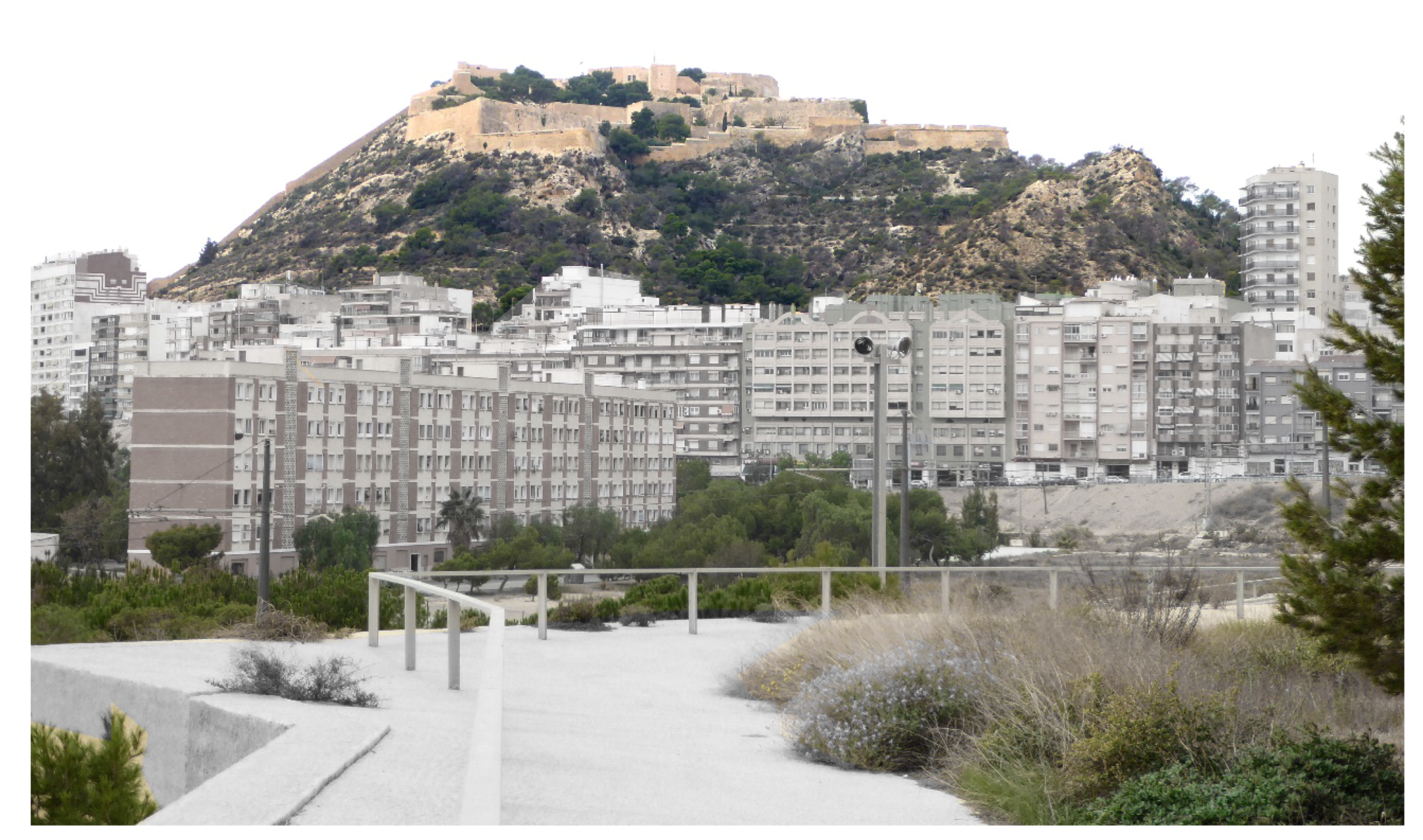
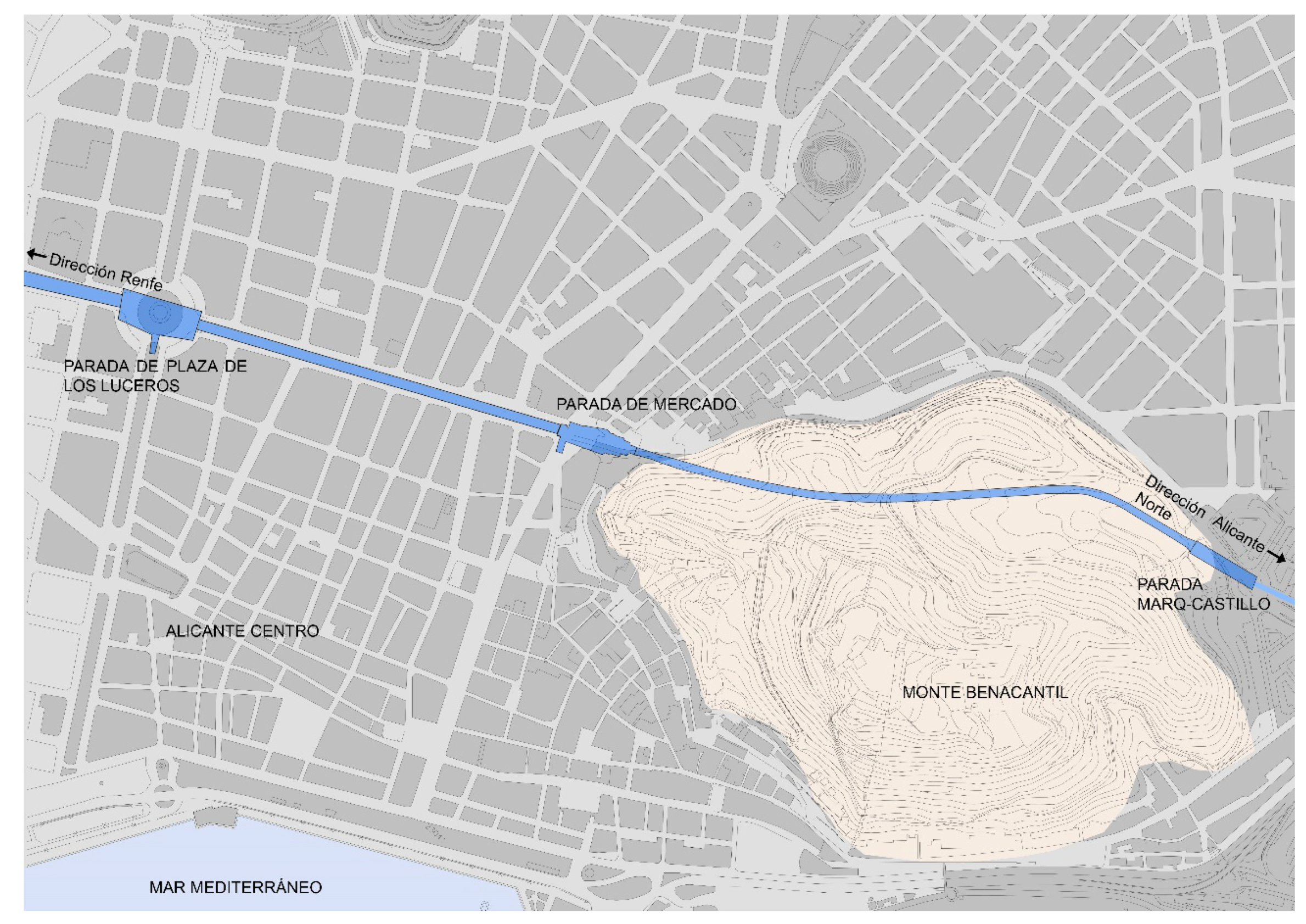
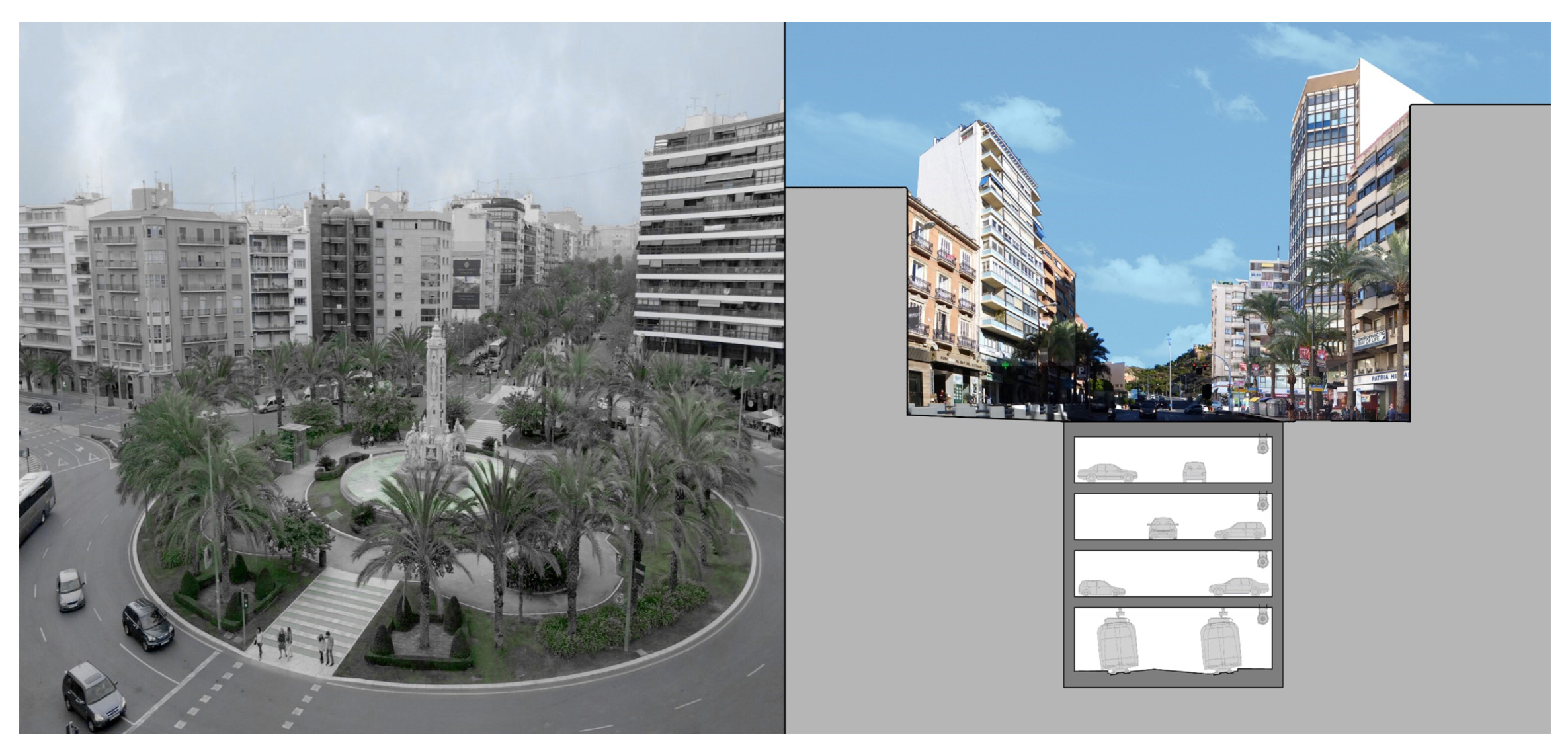

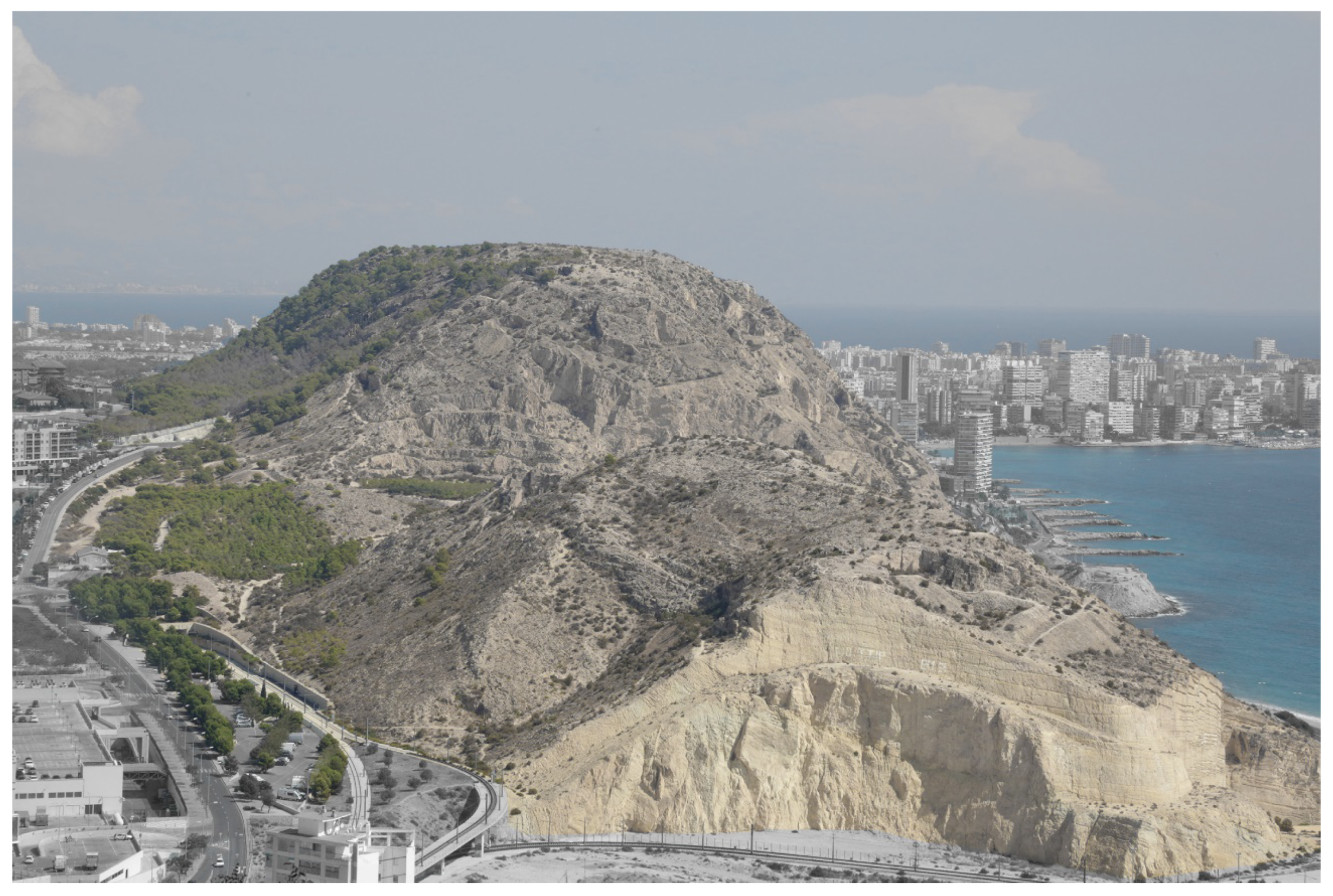


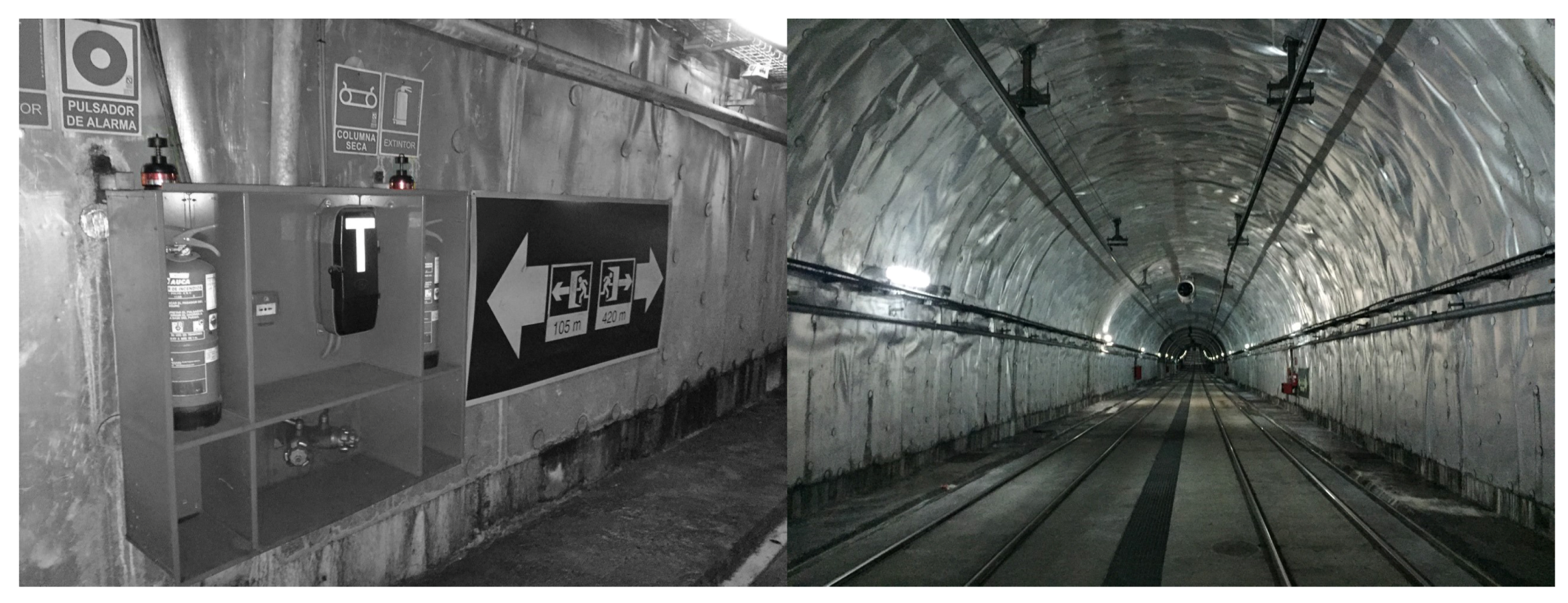
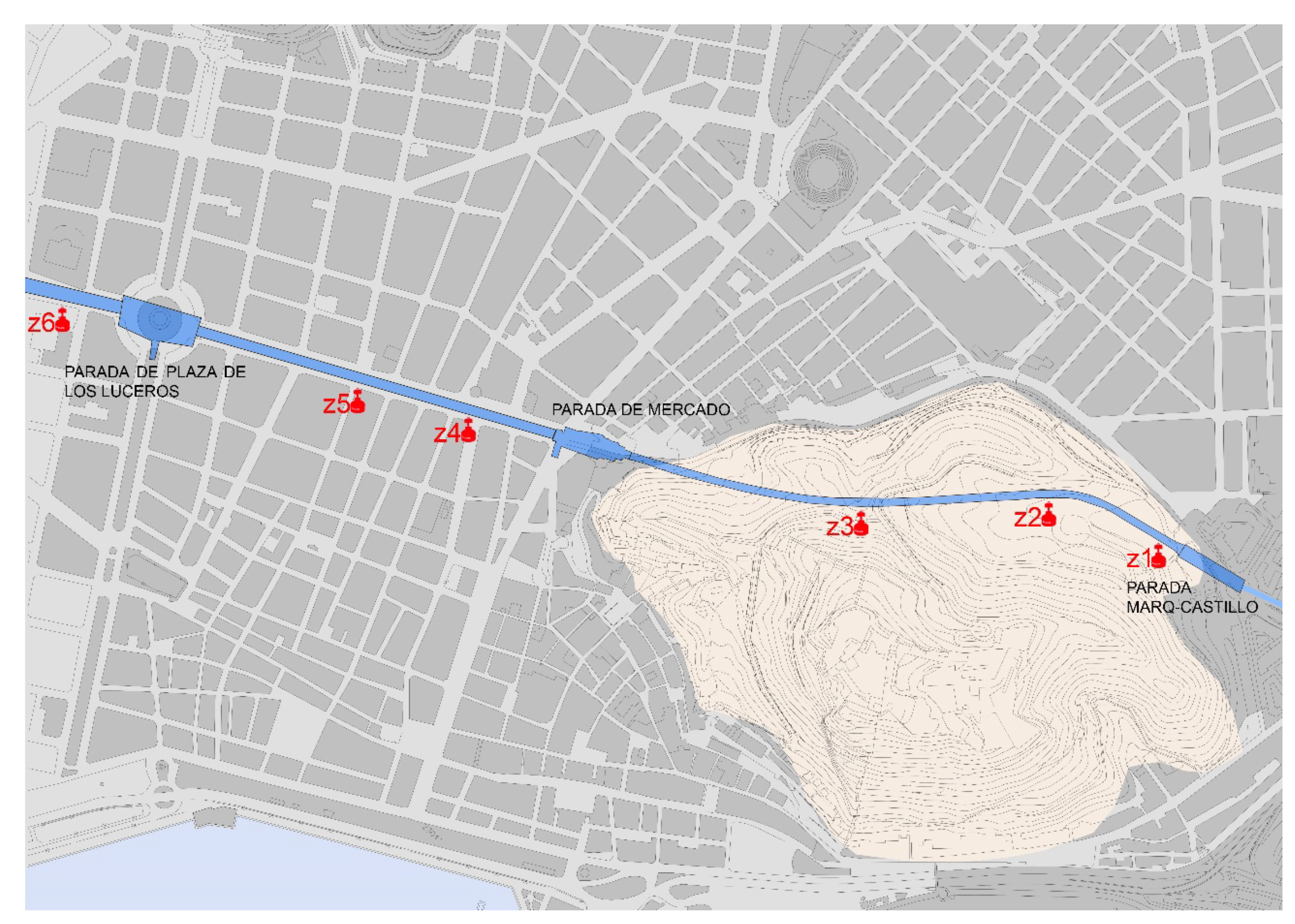
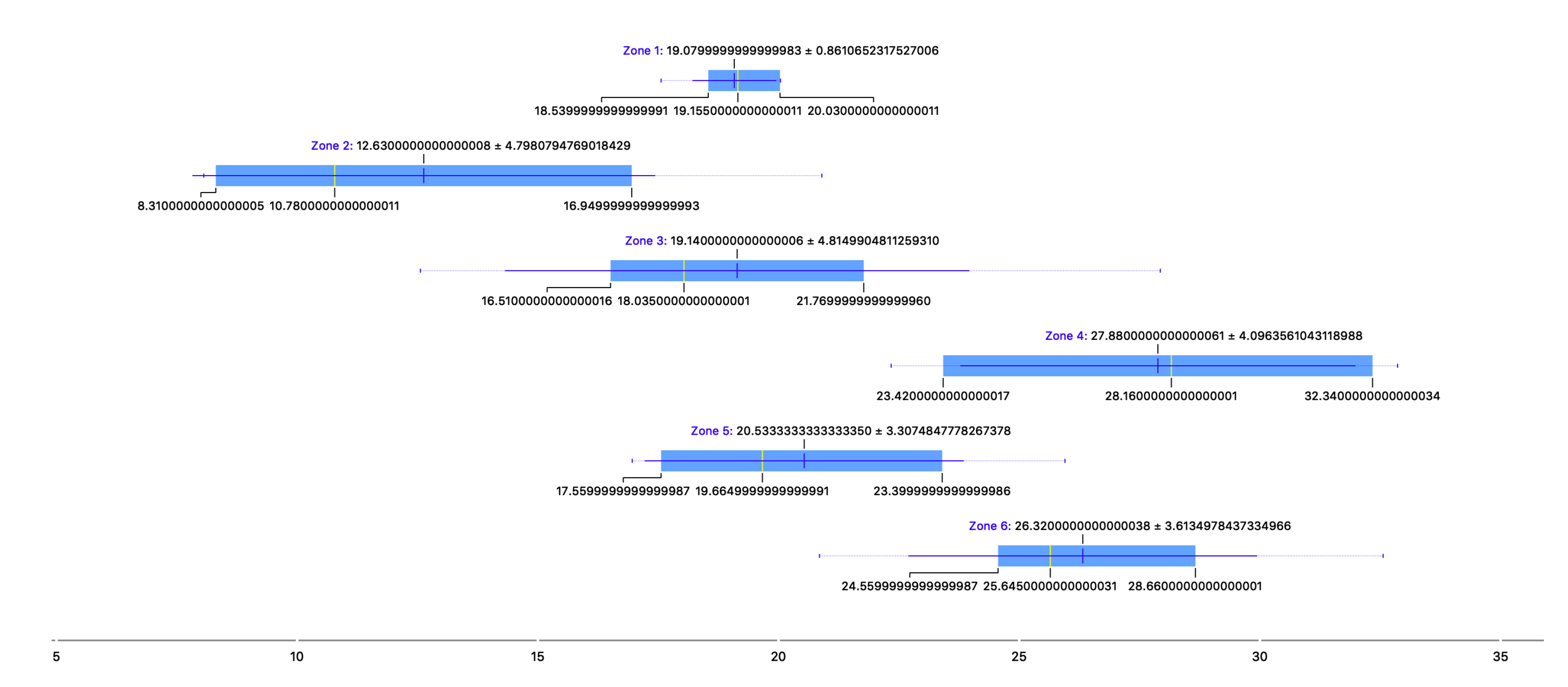

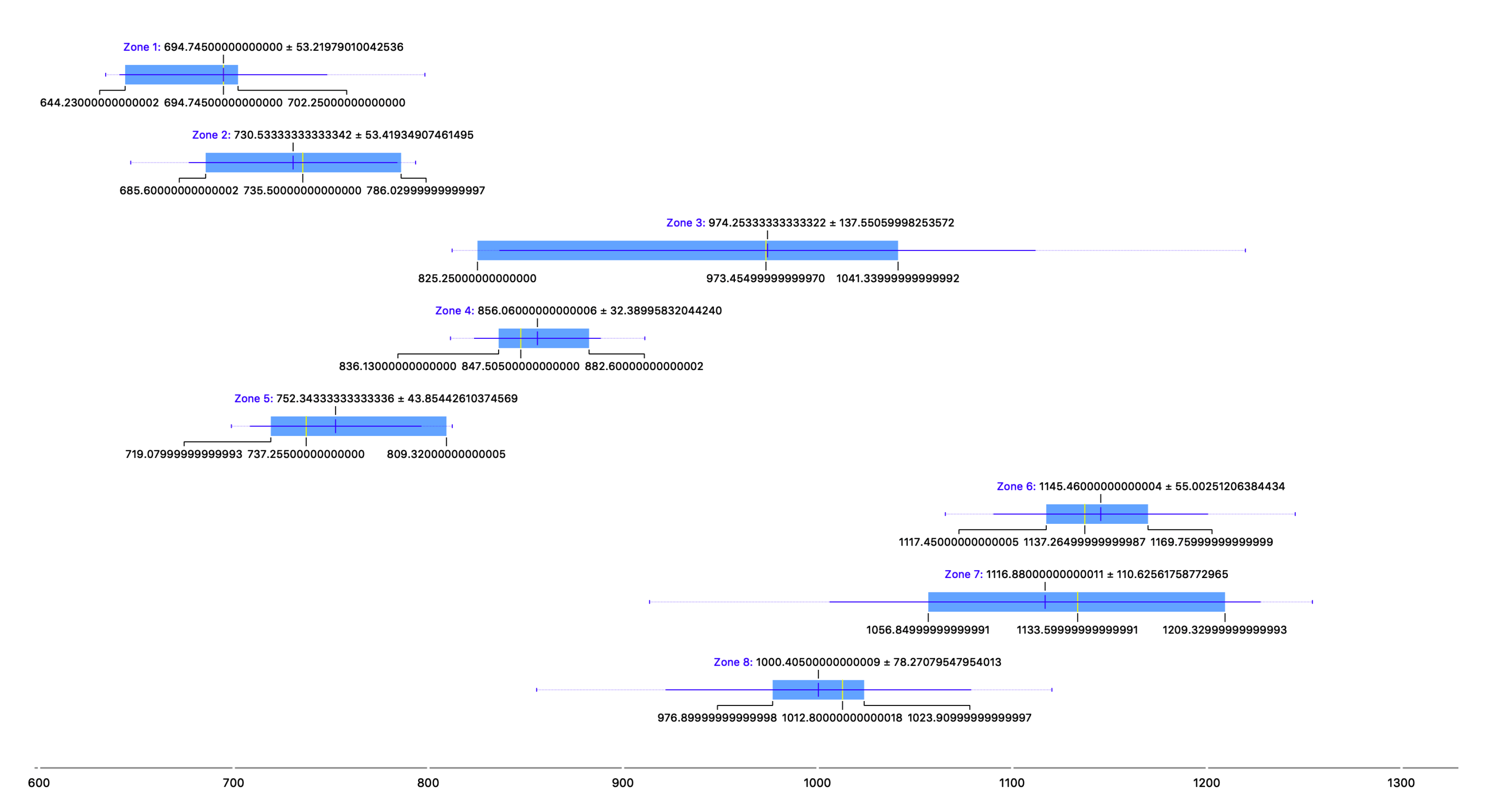
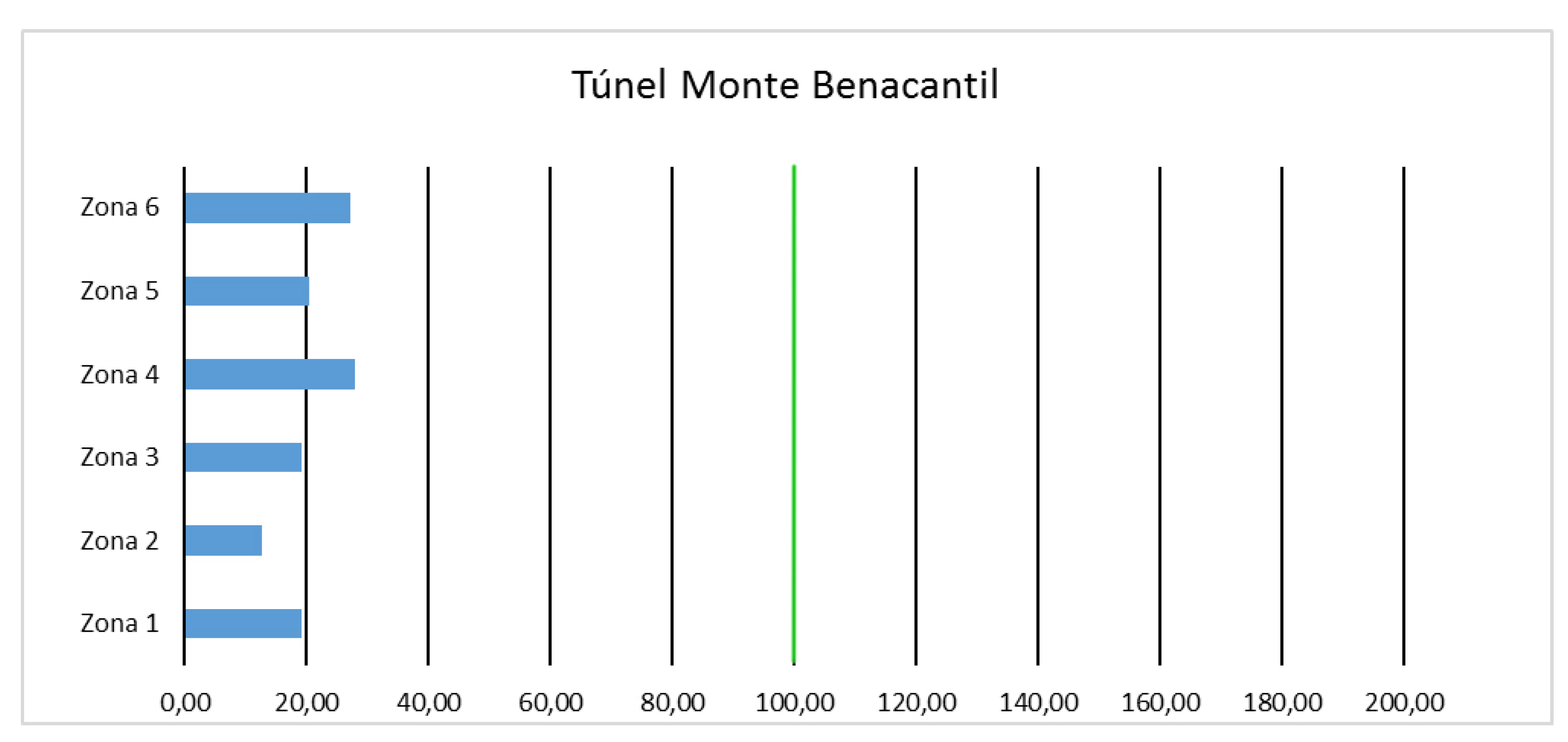
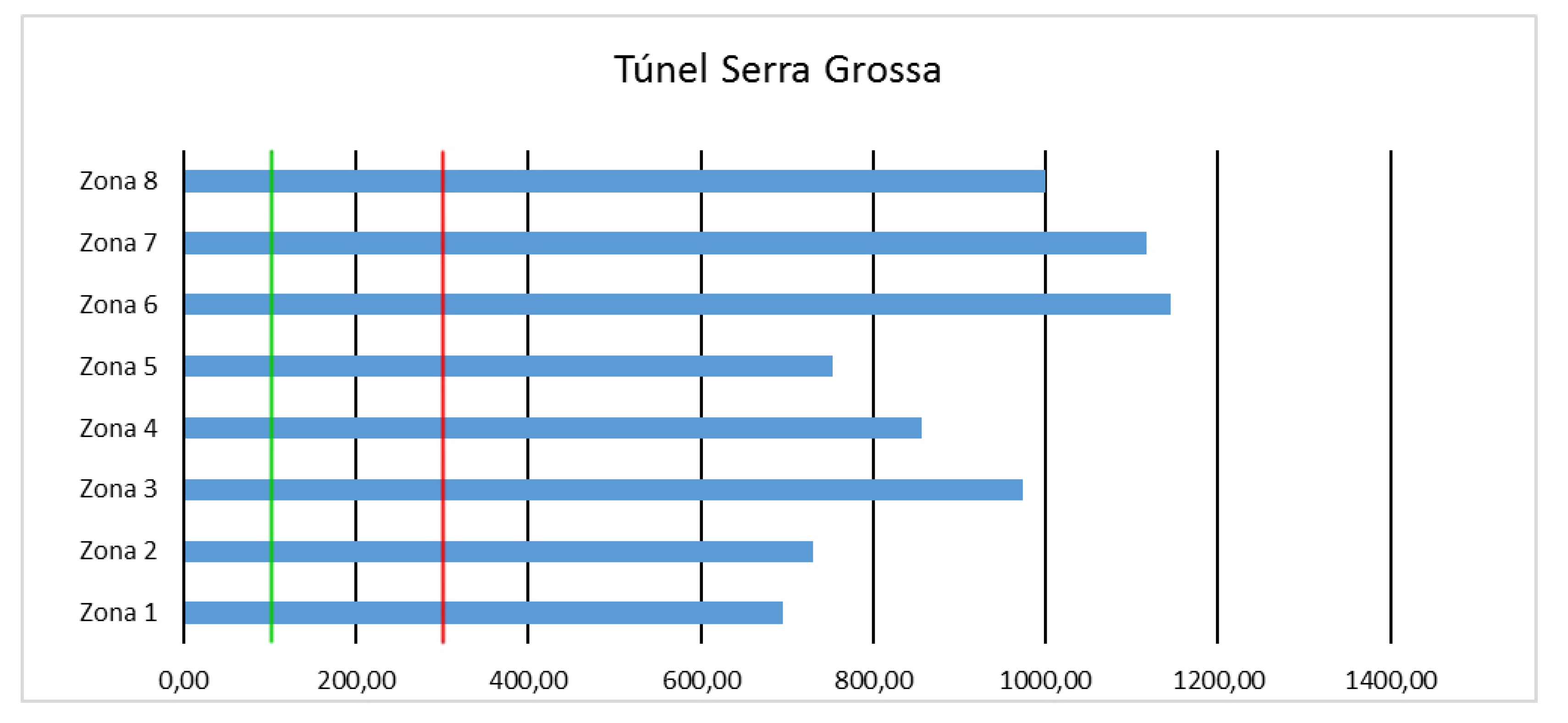
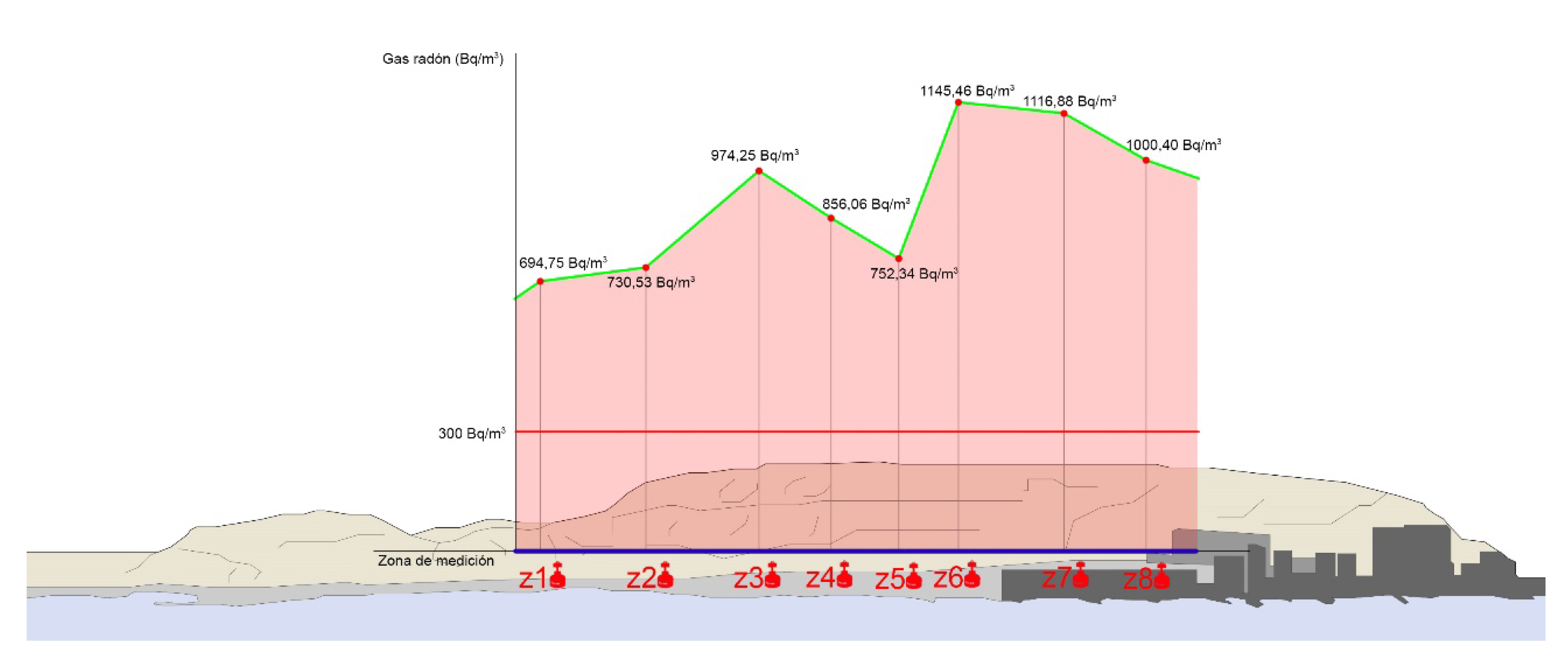
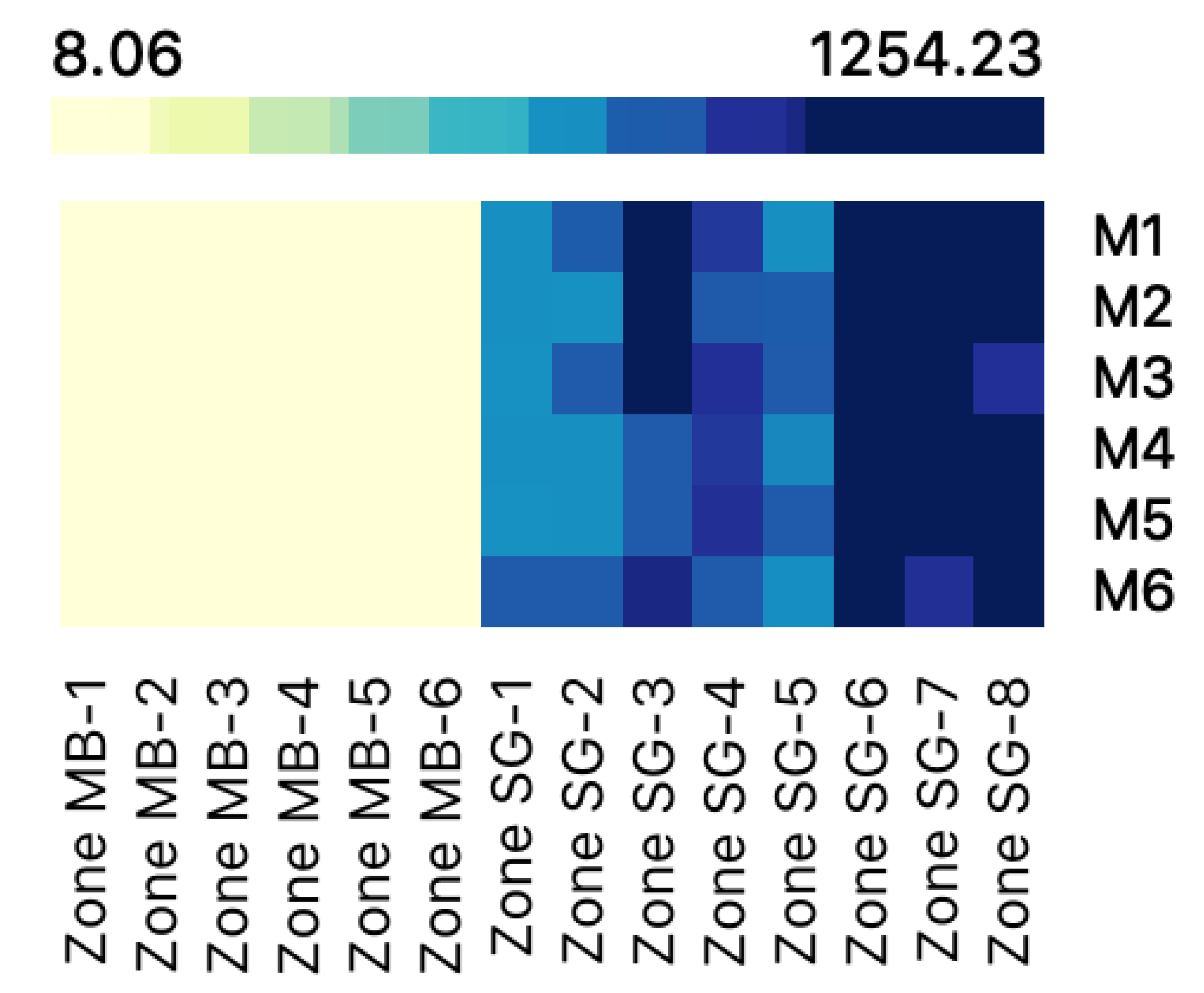
| SUMMARY OF MEASUREMENTS IN THE SERRA GROSSA TUNNEL | |||
|---|---|---|---|
| Zone | Place | Number of Samples | Average Concentration Radon Gas (Bq/m) |
| Zone 1 | 100 m from the south entrance | 6 | 694.75 |
| Zone 2 | 300 m from the south entrance | 6 | 730.53 |
| Zone 3 | 500 m from the south entrance | 6 | 974.25 |
| Zone 4 | 600 m from the south entrance | 6 | 856.06 |
| Zone 5 | 700 m emergency exit | 6 | 752.34 |
| Zone 6 | 800 m from the south entrance | 6 | 1145.46 |
| Zone 7 | 1300 m from the south entrance | 6 | 1116.88 |
| Zone 8 | 1400 m from south entrance | 6 | 1000.40 |
© 2019 by the authors. Licensee MDPI, Basel, Switzerland. This article is an open access article distributed under the terms and conditions of the Creative Commons Attribution (CC BY) license (http://creativecommons.org/licenses/by/4.0/).
Share and Cite
Rizo-Maestre, C.; Echarri-Iribarren, V.; Galiano-Garrigós, A. Ventilation as an Indispensable Tool for Healthy Constructions: Comparison of Alicante’s Urban Railway Tunnels. Sustainability 2019, 11, 6205. https://doi.org/10.3390/su11226205
Rizo-Maestre C, Echarri-Iribarren V, Galiano-Garrigós A. Ventilation as an Indispensable Tool for Healthy Constructions: Comparison of Alicante’s Urban Railway Tunnels. Sustainability. 2019; 11(22):6205. https://doi.org/10.3390/su11226205
Chicago/Turabian StyleRizo-Maestre, Carlos, Víctor Echarri-Iribarren, and Antonio Galiano-Garrigós. 2019. "Ventilation as an Indispensable Tool for Healthy Constructions: Comparison of Alicante’s Urban Railway Tunnels" Sustainability 11, no. 22: 6205. https://doi.org/10.3390/su11226205
APA StyleRizo-Maestre, C., Echarri-Iribarren, V., & Galiano-Garrigós, A. (2019). Ventilation as an Indispensable Tool for Healthy Constructions: Comparison of Alicante’s Urban Railway Tunnels. Sustainability, 11(22), 6205. https://doi.org/10.3390/su11226205





